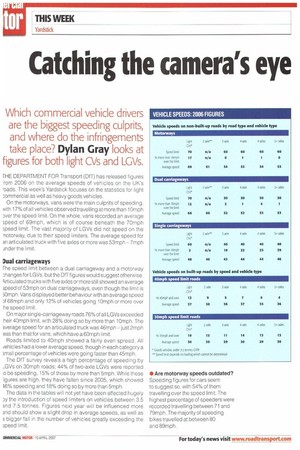Catching the camera's eye
Page 28

If you've noticed an error in this article please click here to report it so we can fix it.
Which commercial vehicle drivers are the biggest speeding culprits, and where do the infringements take place? Dylan Gray looks at figures for both light CVs and LGVs.
THE DEPARTMENT FOR Transport (DfT) has released figures 'rem 2006 on the average speeds of vehicles on the UK's "oads. This week's Yardstick focuses on the statistics for light commercial as well as heavy goods vehicles.
On the motorways, vans were the main culprits of speeding, Nith 17% of all vehicles observed travelling at more than lOmph Dver the speed limit. On the whole, vans recorded an average speed of 69mph, which is of course beneath the 70mph speed limit. The vast majority of LGVs did not speed on the Tiotorway, due to their speed limiters. The average speed for an articulated truck with five axles or more was 53mph — 7mph under the limit.
Dual carriageways
The speed limit between a dual carriageway and a motorway changes for LGVs, but the DfT figures would suggest otherwise.
rticulated trucks with five axles or more still showed an average speed of 53mph on dual carriageways, even though the limit is 50mph. Vans displayed better behaviour with an average speed Df 68mph and only 12% of vehicles going lOmph or more over be speed limit.
On major single-carriageway roads 76% of all LGVs exceeded heir 40mph limit, with 28% doing so by more than lOmph. The average speed for an articulated truck was 46mph — just 2mph ess than that for vans, which have a 60mph limit.
Roads limited to 40mph showed a fairly even spread. All tehicles had a lower average speed, though in each category a small percentage of vehicles were going faster than 45mph.
The DfT survey reveals a high percentage of speeding by _GVs on 30mph roads; 44% of two-axle LGVs were reported o be speeding, 15% of those by more than 5mph. While these igures are high, they have fallen since 2005, which showed 46% speeding and 18% doing so by more than 5mph.
The data in the tables will not yet have been affected hugely Dy the introduction of speed limiters on vehicles between 3.5 and 7.5 tonnes. Figures next year will be influenced more and should show a slight drop in average speeds, as well as a bigger fall in the number of vehicles greatly exceeding the speed limit.
























































































































































































































